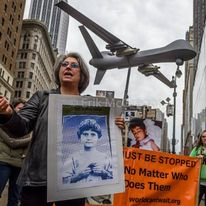Victoria Ross
Visits: 52Killer drones and associated surveillance are a crime – immoral, illegal, and foolhardy. They must be banned for the[…]
Read more

Visits: 52Killer drones and associated surveillance are a crime – immoral, illegal, and foolhardy. They must be banned for the[…]
Read more
Visits: 58The Interfaith Peace Network of WNY is proud and honored to endorse the vitally important Ban Killer Drones Campaign.[…]
Read more
Visits: 59Since 1915, the Fellowship of Reconciliation has stood as a community of believers from all faiths and traditions in[…]
Read more

Visits: 65In the early days of the work of the Global Network we learned about drones (then called Unmanned Aerial[…]
Read more
Visits: 50In the last 20 years, we have watched the growing human suffering being generated by the atrocity of drone[…]
Read more
Visits: 61I am frequently asked some variation of the question: “How did you turn from a warrior to a peacenik?” […]
Read more
Visits: 127When the George W. Bush, then Commander in Chief of the year-old U.S. “war on terror,” authorized a Predator[…]
Read more
Visits: 99“Why We Persist” describes the grassroots campaign to ground the MQ9 Reaper drone operation at Hancock AFB, home of the[…]
Read more
Visits: 65Over the past decade armed British Reaper drones, remotely controlled by RAF pilots at RAF Waddington or Creech Air[…]
Read more